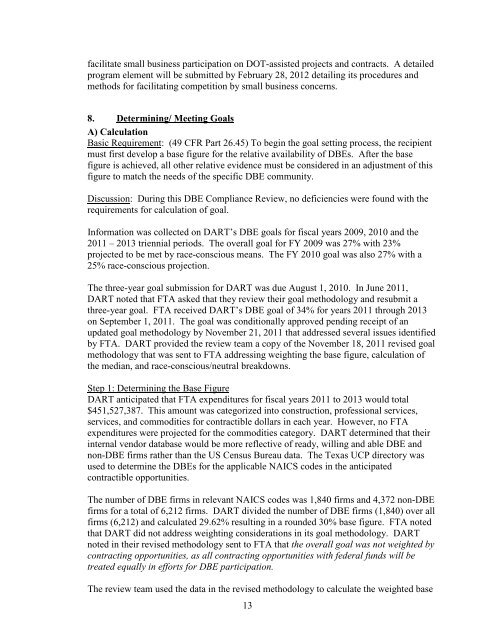Dallas Area Rapid Transit - Federal Transit Administration
Dallas Area Rapid Transit - Federal Transit Administration
Dallas Area Rapid Transit - Federal Transit Administration
Create successful ePaper yourself
Turn your PDF publications into a flip-book with our unique Google optimized e-Paper software.
facilitate small business participation on DOT-assisted projects and contracts. A detailed<br />
program element will be submitted by February 28, 2012 detailing its procedures and<br />
methods for facilitating competition by small business concerns.<br />
8. Determining/ Meeting Goals<br />
A) Calculation<br />
Basic Requirement: (49 CFR Part 26.45) To begin the goal setting process, the recipient<br />
must first develop a base figure for the relative availability of DBEs. After the base<br />
figure is achieved, all other relative evidence must be considered in an adjustment of this<br />
figure to match the needs of the specific DBE community.<br />
Discussion: During this DBE Compliance Review, no deficiencies were found with the<br />
requirements for calculation of goal.<br />
Information was collected on DART’s DBE goals for fiscal years 2009, 2010 and the<br />
2011 – 2013 triennial periods. The overall goal for FY 2009 was 27% with 23%<br />
projected to be met by race-conscious means. The FY 2010 goal was also 27% with a<br />
25% race-conscious projection.<br />
The three-year goal submission for DART was due August 1, 2010. In June 2011,<br />
DART noted that FTA asked that they review their goal methodology and resubmit a<br />
three-year goal. FTA received DART’s DBE goal of 34% for years 2011 through 2013<br />
on September 1, 2011. The goal was conditionally approved pending receipt of an<br />
updated goal methodology by November 21, 2011 that addressed several issues identified<br />
by FTA. DART provided the review team a copy of the November 18, 2011 revised goal<br />
methodology that was sent to FTA addressing weighting the base figure, calculation of<br />
the median, and race-conscious/neutral breakdowns.<br />
Step 1: Determining the Base Figure<br />
DART anticipated that FTA expenditures for fiscal years 2011 to 2013 would total<br />
$451,527,387. This amount was categorized into construction, professional services,<br />
services, and commodities for contractible dollars in each year. However, no FTA<br />
expenditures were projected for the commodities category. DART determined that their<br />
internal vendor database would be more reflective of ready, willing and able DBE and<br />
non-DBE firms rather than the US Census Bureau data. The Texas UCP directory was<br />
used to determine the DBEs for the applicable NAICS codes in the anticipated<br />
contractible opportunities.<br />
The number of DBE firms in relevant NAICS codes was 1,840 firms and 4,372 non-DBE<br />
firms for a total of 6,212 firms. DART divided the number of DBE firms (1,840) over all<br />
firms (6,212) and calculated 29.62% resulting in a rounded 30% base figure. FTA noted<br />
that DART did not address weighting considerations in its goal methodology. DART<br />
noted in their revised methodology sent to FTA that the overall goal was not weighted by<br />
contracting opportunities, as all contracting opportunities with federal funds will be<br />
treated equally in efforts for DBE participation.<br />
The review team used the data in the revised methodology to calculate the weighted base<br />
13
















